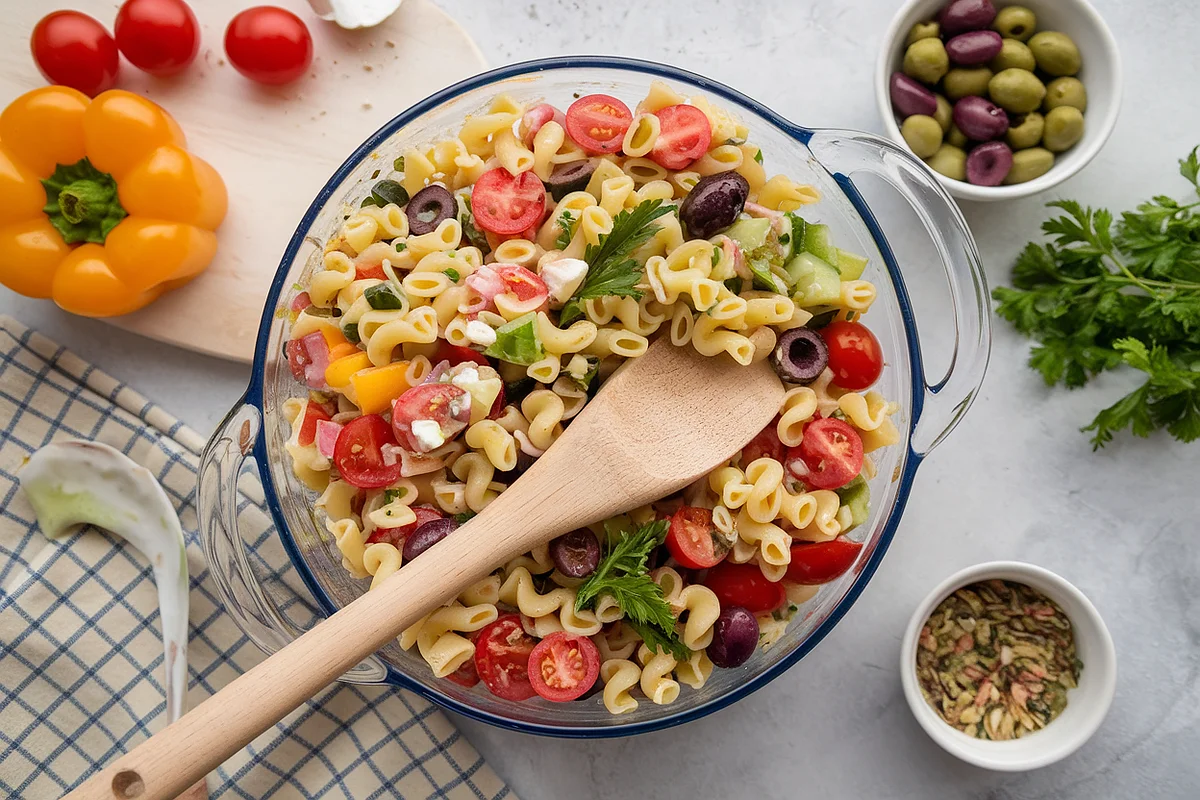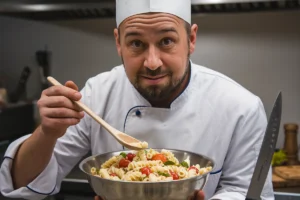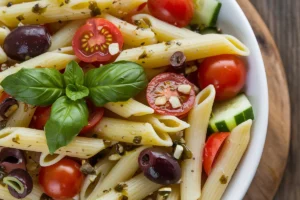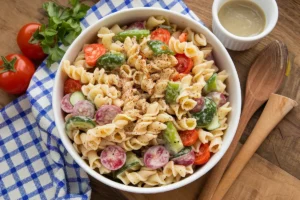Pasta salad is a beloved dish that can be as simple or as complex as you like, making it a staple at summer barbecues, picnics, and family dinners. However, even seasoned cooks can make common mistakes in pasta salad that ruin the balance of flavors and textures in this otherwise easy-to-make dish. To help you achieve pasta salad perfection, it’s crucial to understand and avoid these common mistakes in pasta salad. From selecting the right ingredients to proper preparation techniques, avoiding these common missteps will ensure your pasta salad is always a hit.
This comprehensive guide will walk you through the most frequent mistakes in pasta salad preparation and offer solutions to help you master the art of making a perfect pasta salad every time. By understanding what to avoid and incorporating the right techniques, you’ll create a flavorful, visually appealing, and crowd-pleasing dish.
1. Introduction to Pasta Salad
Pasta salad is a cold dish that combines cooked pasta with various ingredients like vegetables, cheeses, proteins, and dressings. Its appeal lies in its versatility — you can customize it to suit your preferences, dietary needs, or the season’s freshest produce. Pasta salad can be light and refreshing, or it can be hearty and filling, depending on the ingredients you choose.
However, despite its simplicity, there are several pitfalls that can result in a lackluster dish. A perfect pasta salad requires attention to detail, from selecting the right type of pasta to ensuring the dressing is well-balanced. In this guide, we’ll explore the most common mistakes made when preparing pasta salad and how to avoid them for consistently delicious results.
2. Common Mistakes in Pasta Salad Preparation
Choosing the Wrong Type of Pasta
One of the most common mistakes is selecting the wrong type of pasta for your salad. While long pastas like spaghetti or fettuccine may work well in hot dishes, they are impractical for cold pasta salads. Long pasta tends to clump together and becomes difficult to mix with other ingredients.
For pasta salad, opt for short, sturdy pasta shapes like penne, fusilli, farfalle, or rotini. These shapes have ridges and curves that trap the dressing, ensuring every bite is flavorful.
Overcooking or Undercooking the Pasta
Pasta texture is critical in pasta salad. Overcooked pasta turns mushy when combined with dressing, while undercooked pasta can be too firm and unpleasant to eat.
The goal is to cook the pasta al dente, meaning it should be firm to the bite but not hard. Follow the package instructions but begin checking the pasta a minute or two before the recommended cooking time. Once it’s done, drain the pasta immediately to prevent overcooking.
Failing to Rinse Pasta Properly
Unlike hot pasta dishes, pasta for salads should be rinsed in cold water after cooking. This step not only cools the pasta down, preventing it from cooking further, but also removes the surface starch that can cause the pasta to stick together. Without rinsing, you might end up with a clumpy, unappealing salad.
Adding Dressing Too Early
Many people make the mistake of adding the dressing too early. While it’s important for the pasta to absorb some of the dressing for flavor, adding it while the pasta is still warm can cause the pasta to become soggy. Instead, allow the pasta to cool completely before mixing in the dressing.
Additionally, pasta salad benefits from marinating time. Once the salad is assembled, refrigerate it for at least 30 minutes to let the flavors meld together.
Overloading the Salad with Ingredients
A common misconception is that more ingredients automatically result in a better salad. However, overloading your pasta salad with too many vegetables, cheeses, or proteins can overwhelm the dish and lead to an unbalanced flavor profile.
Focus on a few key ingredients that complement each other. The ratio of pasta to other ingredients should be well-balanced, with pasta remaining the star of the dish.
3. Ingredient Selection for a Perfect Pasta Salad
Best Types of Pasta for Salad
As mentioned earlier, the shape of the pasta is crucial. Short pasta shapes like fusilli, farfalle, penne, or rotini work best because they hold up well in salads and are easier to eat. Additionally, these shapes catch and hold the dressing, ensuring that each bite is flavorful.
If you’re catering to specific dietary needs, consider using whole wheat or gluten-free pasta. Both options can work well in pasta salads as long as they’re cooked properly.
Using Fresh, Seasonal Vegetables
Vegetables add both color and texture to your pasta salad, but using fresh, seasonal vegetables will give your dish the best flavor. Summer vegetables like cherry tomatoes, cucumbers, bell peppers, and zucchini are popular choices. During colder months, consider adding roasted vegetables like butternut squash, kale, or Brussels sprouts for a heartier salad.
In addition to selecting the freshest vegetables, ensure they’re prepared properly. Chop vegetables into bite-sized, uniform pieces for consistent texture and easy mixing.
Incorporating High-Quality Cheeses
Cheese can add a delightful creaminess and depth of flavor to your pasta salad. However, using low-quality or overly processed cheese can detract from the overall taste. Opt for fresh mozzarella, crumbled feta, or grated Parmesan for the best results.
When adding cheese, use it in moderation. Too much cheese can overpower the other ingredients and make the salad too rich. Small mozzarella balls (bocconcini) or crumbled feta are excellent choices for adding texture and flavor without overwhelming the dish.
Adding Protein Wisely
Incorporating protein into your pasta salad can make it a more substantial dish. Grilled chicken, shrimp, tuna, tofu, or beans are popular choices. However, balance is key — the protein should complement the salad rather than dominate it.
When adding protein, consider its preparation. For example, grilled chicken or marinated tofu will provide a better texture and flavor than boiled or bland options.
4. Dressing Your Pasta Salad the Right Way
Creating a Balanced Dressing
The dressing is what ties all the ingredients together in a pasta salad. The key is to strike a balance between flavors — too much dressing can make the salad soggy, while too little can result in a bland dish.
A classic pasta salad dressing typically consists of olive oil, vinegar, and mustard or lemon juice. For a creamier dressing, you might use a base of Greek yogurt or mayonnaise. Start by whisking the dressing ingredients together, and then gradually add them to the salad, tossing until everything is evenly coated.
Choosing the Right Oils and Vinegars
The quality of your dressing ingredients matters. Opt for extra virgin olive oil and high-quality vinegars, such as balsamic, white wine, or red wine vinegar. These ingredients will add richness and depth to the salad, while cheaper alternatives may leave your dressing lacking in flavor.
Don’t be afraid to experiment with different types of vinegars and oils. For a unique twist, try citrus-infused oils or flavored vinegars like apple cider vinegar for a refreshing variation.
Enhancing Flavor with Fresh Herbs and Seasonings
Fresh herbs like basil, parsley, and oregano can elevate the flavor of your pasta salad. Be sure to chop them finely and mix them evenly throughout the salad. Salt, pepper, and seasonings like garlic or onion powder are also essential for adding depth to the dressing.
If you’re aiming for a Mediterranean-inspired pasta salad, consider adding oregano and rosemary. For a more tropical flavor, cilantro or mint can be excellent choices. Using fresh, aromatic herbs will brighten your dish and give it a burst of flavor.
5. Tips for Preparing Pasta Salad
Keeping the Ingredients Fresh
Pasta salad is best when it’s fresh, so avoid making it too far in advance. If you need to prepare it ahead of time, store the salad and the dressing separately and combine them just before serving to maintain texture and flavor.
Proper Temperature Control
Temperature plays an important role in the texture of your salad. Ensure the pasta has cooled down before mixing it with the other ingredients, particularly if you’re adding cheese or leafy greens, which can wilt or melt if exposed to hot pasta.
If you’re in a hurry, use an ice bath to cool the pasta quickly. After draining, submerge the pasta in a bowl of ice water for a few minutes, then drain it thoroughly before proceeding with the recipe.
Balancing Textures and Flavors
Pasta salad is all about balance. You want a variety of textures and flavors to create a harmonious dish. Think about contrast: creamy cheeses with crisp vegetables, hearty pasta with tender proteins, and a tangy dressing with subtle sweetness.
Don’t forget to season your salad generously. Salt, pepper, herbs, and a good-quality dressing are essential for bringing out the natural flavors of your ingredients.
6. Storing and Serving Pasta Salad
How to Store Leftovers
If you have leftover pasta salad, store it in an airtight container in the fridge. Keep in mind that pasta salad can become soggy if left too long, especially if it’s been dressed. To prevent this, store the dressing separately if possible and mix just before serving.
When reheating, pasta salad is typically served cold, so there’s no need to heat it up. However, if you’d like to refresh the salad, you can add a little extra dressing or toss in some fresh herbs or vegetables.
Serving Suggestions and Presentation Tips
Presentation matters, especially when serving pasta salad at a gathering. Use a large, shallow serving bowl to showcase the colors and textures of the salad. Garnish with fresh herbs, a drizzle of olive oil, or a sprinkle of cheese for an added touch of elegance.
Consider pairing your pasta salad with complementary dishes, such as grilled meats, crusty bread, or a crisp green salad. This will help balance out the richness of the pasta salad and create a well-rounded meal.
7. Creative Pasta Salad Variations
Pasta salad is incredibly adaptable, and there are countless variations you can try to keep things interesting. Here are a few ideas to get you started:
- Mediterranean Pasta Salad: Combine rotini pasta with cherry tomatoes, cucumber, kalamata olives, feta cheese, and a lemon-oregano vinaigrette for a Mediterranean-inspired dish.
- Italian Pasta Salad: Use penne or fusilli with salami, mozzarella, roasted red peppers, artichoke hearts, and a zesty Italian dressing.
- Asian-Inspired Pasta Salad: Try a sesame-soy dressing with soba noodles, shredded cabbage, carrots, edamame, and grilled chicken or tofu.
- Creamy Ranch Pasta Salad: Mix rotini pasta with chopped bacon, cheddar cheese, green onions, and a creamy ranch dressing for a hearty, crowd-pleasing dish.
8. Frequently Asked Questions (FAQs)
What are the most common mistakes in pasta salad preparation?
Some of the most frequent mistakes include overcooking pasta, failing to rinse it properly, adding the dressing too early, and overloading the salad with too many ingredients.
Can I make pasta salad ahead of time?
Yes, you can make pasta salad ahead of time, but it’s best to store the salad and the dressing separately to prevent sogginess. Combine them just before serving for optimal freshness.
How do I keep pasta salad from becoming too dry or soggy?
To avoid a dry salad, be sure to add enough dressing and let the pasta absorb some of it. To prevent sogginess, avoid over-dressing the salad, especially if you’re storing it for later. It’s best to mix in the dressing just before serving.
What proteins can I add to pasta salad?
Grilled chicken, shrimp, tuna, tofu, and beans are popular choices for adding protein to pasta salad. Ensure the protein complements the other flavors in the dish for a balanced salad.
9. Conclusion
Pasta salad is a dish that can be enjoyed year-round, offering endless possibilities for customization and creativity. However, it’s easy to make mistakes that can compromise the flavor, texture, and overall quality of your dish. By avoiding common pitfalls such as overcooking pasta, under-seasoning dressings, and adding too many ingredients, you can ensure that your pasta salad is always a hit.
Remember, the key to a great pasta salad lies in the balance of flavors and textures. Use fresh, high-quality ingredients, experiment with different dressings and herbs, and always taste as you go. With the tips and strategies provided in this guide, you’re well on your way to mastering the perfect pasta salad. Whether you’re making a classic Italian pasta salad or experimenting with bold, creative flavors, the possibilities are endless!



